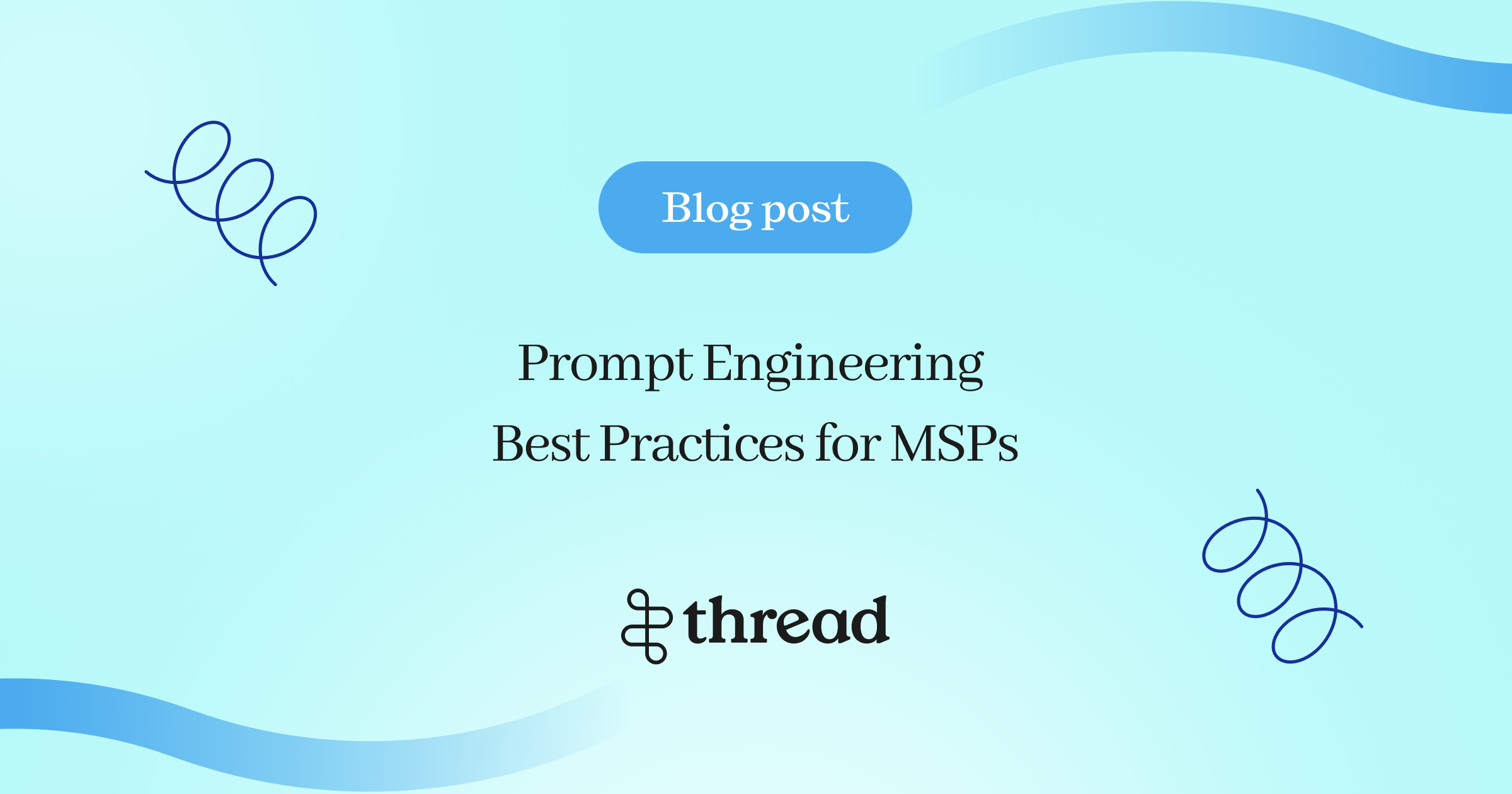Smarter AI Starts with Better Prompts
Improve your AI's performance with clear, structured prompts to enhance efficiency and client satisfaction for your MSP.

AI is everywhere in the MSP world right now. Some see it as the silver bullet. Others worry it’s going to flood their service desk with bad outputs, awkward conversations, and frustrated customers. The truth? AI can be your best technician or your worst intern — and the difference comes down to one thing: prompt engineering.
Prompt engineering is the craft of teaching AI how to think, talk, and act in ways that match your MSP’s service desk culture. It’s not about coding. It’s about clarity. If you can write clear instructions for a dispatcher, you can write prompts for AI.
At Thread, we’ve seen partners scale faster and deliver more consistent customer experiences simply by tightening up their prompts. At our recent Magic Camp workshop, we pulled back the curtain on what works — and what doesn’t — when you’re training AI to triage tickets, generate titles, or respond to end users.
AI isn’t like the rest of your tool stack. A PSA runs on fixed rules. An RMM runs on scripts. But an AI runs on instructions — and those instructions are whatever you tell it. That means the quality of your output lives or dies on the clarity of your input.
Get it right, and your triage agent feels like your best technician: tickets are routed cleanly, titles are standardized, escalations happen only when they should, and customers get responses that feel clear, confident, and on-brand.
Get it wrong, and the same agent becomes your worst intern: improvising steps, mangling ticket titles, escalating too much or not enough, and leaving both techs and end users frustrated.
That’s why prompt engineering matters. It’s not about “tricking” AI — it’s about teaching it to follow the same playbook your team already uses. The clearer the playbook, the better the AI performs.
AI is different from every other tool in your stack. A PSA runs off fixed rules. RMMs run off scripts. But AI runs off instructions — and those instructions (prompts) are what shape the quality of the output.
The takeaway: if you want your AI agent to act like your best tech, you need to train it like your best tech.
When it comes to training AI for your service desk, the rules are surprisingly simple. There are practices that consistently deliver clean, reliable results — and pitfalls that almost guarantee chaos. Here’s the short list every MSP team should keep handy.
Start every prompt by telling the AI who it is and how it should behave. One of the best frameworks here is RAFT:
That clarity gives the AI an identity and boundaries — just like onboarding a new hire.
AI gets dangerous when it makes up answers. Guardrails keep it safe. Use “if/then” rules to stop bad outputs before they happen.
Example:
Think of these as your “do not cross” lines. Without them, AI will happily take guesses.
AI works best when it follows a sequence. Don’t just say “help the user set up email.” Break it down like you would for a dispatcher:
This isn’t just clarity — it’s repeatability. Your AI will handle tickets the same way, every time.
Show, don’t just tell. Give AI examples of what good outputs look like — and what bad ones look like.
Example:
This technique (“few-shot prompting”) dramatically improves consistency, especially for things like ticket titles where accuracy matters.
Large Language Models (LLMs) like GPT have context limits. In Thread, you’ve got about 5,000 characters to work with.
Don’t try to shove every possible scenario into one mega-prompt. Instead:
The result? Faster, cleaner outputs that don’t break midstream.
“Help the user with mobile setup” is a recipe for improvisation. Be explicit: “Direct the user to download the Microsoft Authenticator app from the App Store (iOS) or Google Play (Android). Do not suggest ActiveSync.”
Vague prompts = vague outputs.
Packing a single prompt with every possible scenario makes it unreadable — for both humans and AI. Instead, build modular intents that handle specific issues (e.g., mobile setup, password reset, VPN connection).
Think “Lego blocks,” not “war and peace.”
It’s not enough to show AI the right way. Show it what wrong looks like too. Negative examples (“never do this”) are critical for avoiding embarrassing outputs.
Example:
AI is powerful, but it’s not a mind reader. If you don’t tune your prompts, you’ll get generic, inconsistent results. The best MSPs treat AI like a junior tech: coach it, test it, refine it.
You’re not alone. Hundreds of MSPs are solving the same challenges with triage agents, title rules, and intent design.
That’s why communities like Thread’s Discord (and groups like MSPGeek) exist. Sharing what works (and what fails) accelerates everyone’s progress.
Prompt engineering isn’t about turning your MSP into a team of AI scientists. It’s about giving AI the clarity it needs to scale your service desk without sacrificing quality.
Do it right, and you’ll have an AI that triages cleanly, titles consistently, and supports your techs instead of second-guessing them. Do it wrong, and you’ll have chaos.
The choice is yours: will your AI be your best technician, or your worst intern?
👉 Want to see how Thread partners are scaling with AI-driven triage? Book a demo with our team.
Improve your AI's performance with clear, structured prompts to enhance efficiency and client satisfaction for your MSP.
MSPs can effectively incorporate AI into their services with thoughtful strategy, clear goals, and a focus on measurable ROI, ensuring sustainable...
Discover how MSPs can leverage AI to enhance marketing efforts, compete with larger firms, and drive growth through efficiency and scalability.
Sign up for our newsletter to get the latest and greatest delivered directly to your inbox by Aerosmith. just kidding, it's us, and the newsletter is awesome.